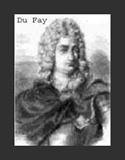Cisternay Du Fay, Charles François de
Charles François de Cisternay Du Fay (1698-1739), French chemist who discovered that electrical charges have both positive and negative values. From the mid-18th through the early 19th centuries, scientists believed that electricity was composed of a fluid. In 1733, Du Fay announced that electricity consists of two fluids: "vitreous" (Latin for "glass"), or positive, electricity, and "resinous," or negative, electricity. During his experiments, when suspending a thread on glass poles, Du Fay noted that a certain amount of the current was lost to the surrounding air. In order to eliminate this loss of energy, he recommended that the cords be wrapped with some nonconductor so as to be "insulated," or "isolee" as he said, first making use of this term. In 1732, the King of France, Louis XV, appointed Du Fay as Superintendent (Director) of the royal gardens in Paris (Jardin du Roi); as a result, he became an active botanist. In the last years of his life, Du Fay focused his work on the optical properties of crystals.
Further Reading
- University of Texas at Austin Physics Department. A Brief Chronological History of Great Discoveries in Electricity.
- World Wide School. Experiments of Cisternay Dufay.
